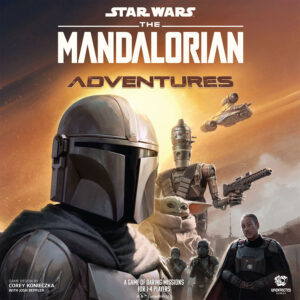 I’m not sure if you were like me, but I couldn’t wait for The Mandalorian series to drop in late 2019. It was the first newly created series on Disney+ and I have rewatched that season at least 4 times before Season 2 dropped because it was so good. Fast forward and we’re waiting on Season 4 to drop possibly in late 2025 or Spring 2026 which feels like forever.
I’m not sure if you were like me, but I couldn’t wait for The Mandalorian series to drop in late 2019. It was the first newly created series on Disney+ and I have rewatched that season at least 4 times before Season 2 dropped because it was so good. Fast forward and we’re waiting on Season 4 to drop possibly in late 2025 or Spring 2026 which feels like forever.
This brings us to today’s review of The Mandalorian: Adventures from Unexpected Games. This campaign adventure style cooperative game has 1-4 players experiencing Season 1 of the series trying to solve mission objectives and avoid defeat before the next mission. Each game session plays in about 30-60 minutes depending on mission and player count.
Game Overview:
“This is the Way“
Players need to decide if they’re following the characters listed in the mission briefing in the Mission book or if they are playing one of the other player modes such as Sandbox, Shared, or Solo. Players also need to decide which of the 3 difficulty modes they want to use. After the modes are decided each player will choose and take their character’s unique skill deck of 12 cards—drawing 4 to begin with after shuffling—and standee that is placed on the mission starting space.

Each mission will have a variable setup of threats both face up and down on the mission map. The other decks, aside from the player decks, are the planning deck which mostly gives players advantages, and the event deck which will activate threats on the mission map and add reinforcements. Lastly, disrupt tokens are placed on each mission action slot with the numbers face-up.
The game is played over a series of turns starting with the first player who may perform the following steps in order on their turn:
- Action: a player can use two skill cards to make two different actions: move, attack, intel, or plan.
- Event: a player now checks the action slots where they placed their skill cards and checks the total value (including Disrupt tokens). If the total is five, then draw from the Event deck and resolve the card, and if it’s higher, then resolve the mission crisis first and then the Event deck. If an Event or Crisis is triggered, remove all cards and tokens from that action slot after both have been resolved and return the player cards to the appropriate player’s discard. If the total is lower than 5 skip this step.
- Draw: draw skills cards so a player has 4 cards in their hand.
The next player then follows the turn steps in order and so on until the mission is completed or the players are defeated.
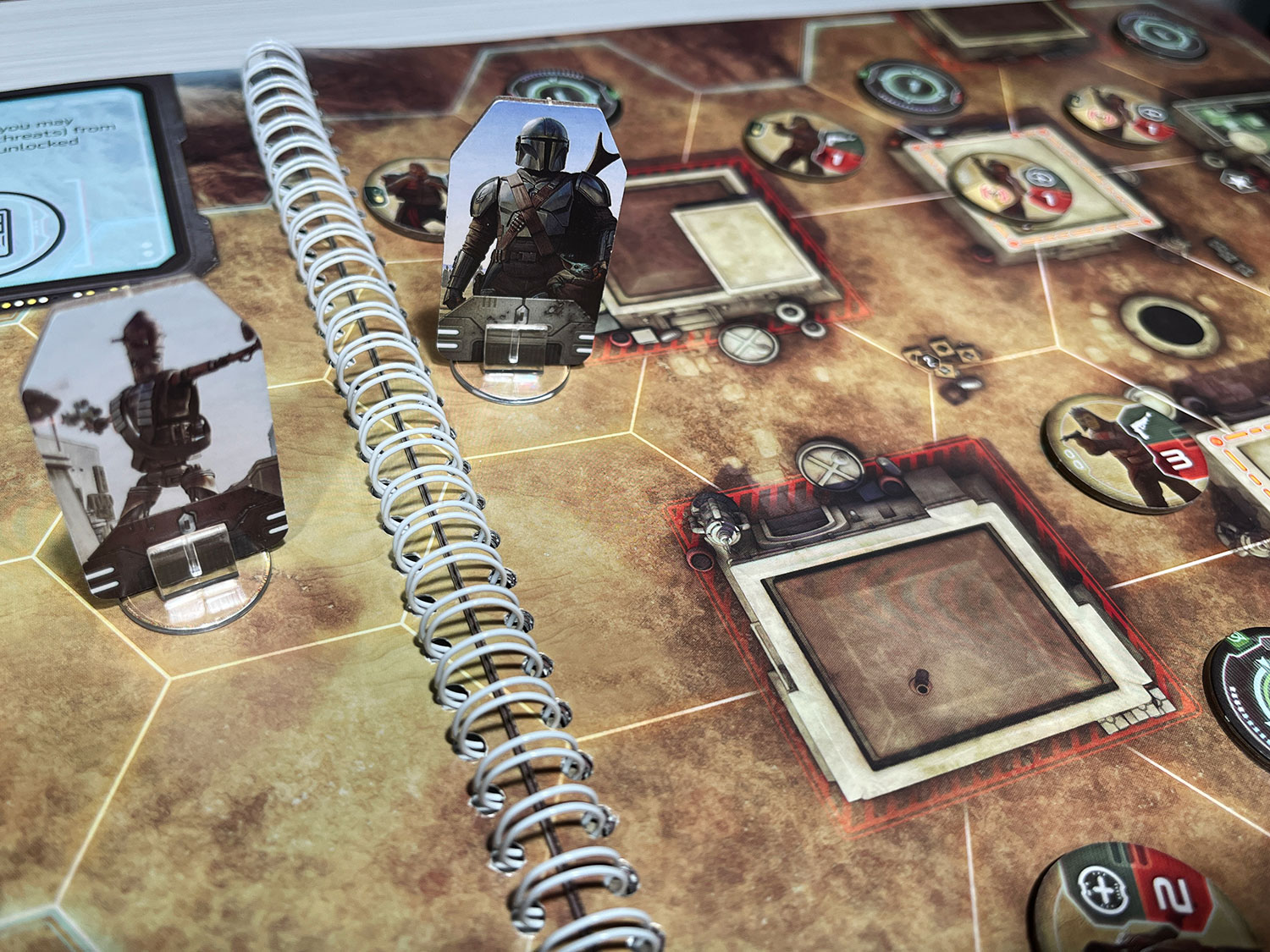
Game Experience:
“I can bring you in warm, or I can bring you in cold“
If you’ve not watched Season 1 of the show, then The Mandalorian: Adventures will act as a spoiler because it is highly thematic and the missions parallel many of the big action scenes of that Season. Plus, the mission book includes comics that have scenes pulled from the show to step up the missions. Now, depending on what characters the players chose, and the mission outcome, things might not exactly emulate the show, but it will be pretty close most of the time and give you a fairly similar look and feel. Also, as you go through the missions, you will unlock more of the guide deck and unseal envelopes for new content. This will help to add to replay value taking you further through Season 1 of the show.
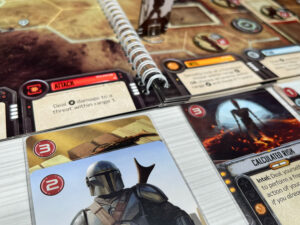
The Mandalorian: Adventures has a cool mechanic with its mission action slots. This gives players a great way to mitigate luck by having 4-5 (depending on the mission) action options to choose from. Plus, you can test your luck if you exceed 5 or more points to trigger an event or crisis and see if it has a little or significant effect on players’ turns so be warned. This mechanic can also be bolstered by a player’s skill card if icons match the action slot which can give bonuses to move, damage, draw, check facedown threats, free actions, and others to help defeat threats and mission objectives. Overall, great mechanic that gives players a nice way to control their fate.
Another great aspect of The Mandalorian: Adventures is the character skills decks. Now unique character decks are not new to gaming but what is great about The Mandalorian: Adventures is that a certain character might go on a mission and ideally successfully complete it—when you unlock new content most if not all characters get new skills cards to add to their decks. This is a great balancing mechanism so if you want to try a different character, they will not feel underpowered or behind skill deck-wise. Plus, the skills decks again add to the theme with images and references pulled straight from Season 1.
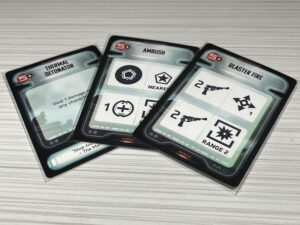
The last thing I wanted to highlight as a plus is the mission book. Again, this is not new where a component is used as the player map, but this one is far superior to most. When I first opened the game, I was bummed there was no significant player aid—well you really don’t need one because the mission maps have almost everything you need, such as where the threats go and if there face up or down, the action slots, crisis info, objective details and locations, special map rules and characters to match the Season 1 mission. Again, amazing details you can literally see and so you’re only really using the rulebook to identify threat icons and special abilities, the mission map has everything else.
Now, I just highlighted that the mission book was a great component but it’s lacking one thing for The Mandalorian: Adventures… more missions. For a game described as an episodic campaign, it is just too short. I’m not going to spoil how many missions are included in the book and come in the additional content, but my group and I finished it and we were all left wanting more. I was reminded that the content included in the base game is Season 1 only (that’s 8 episodes) but knowing that there were some missions that could have been added to bolster the total count. I hope that there’s a Season 2 expansion for The Mandalorian: Adventures on the horizon to provide more missions to try out.
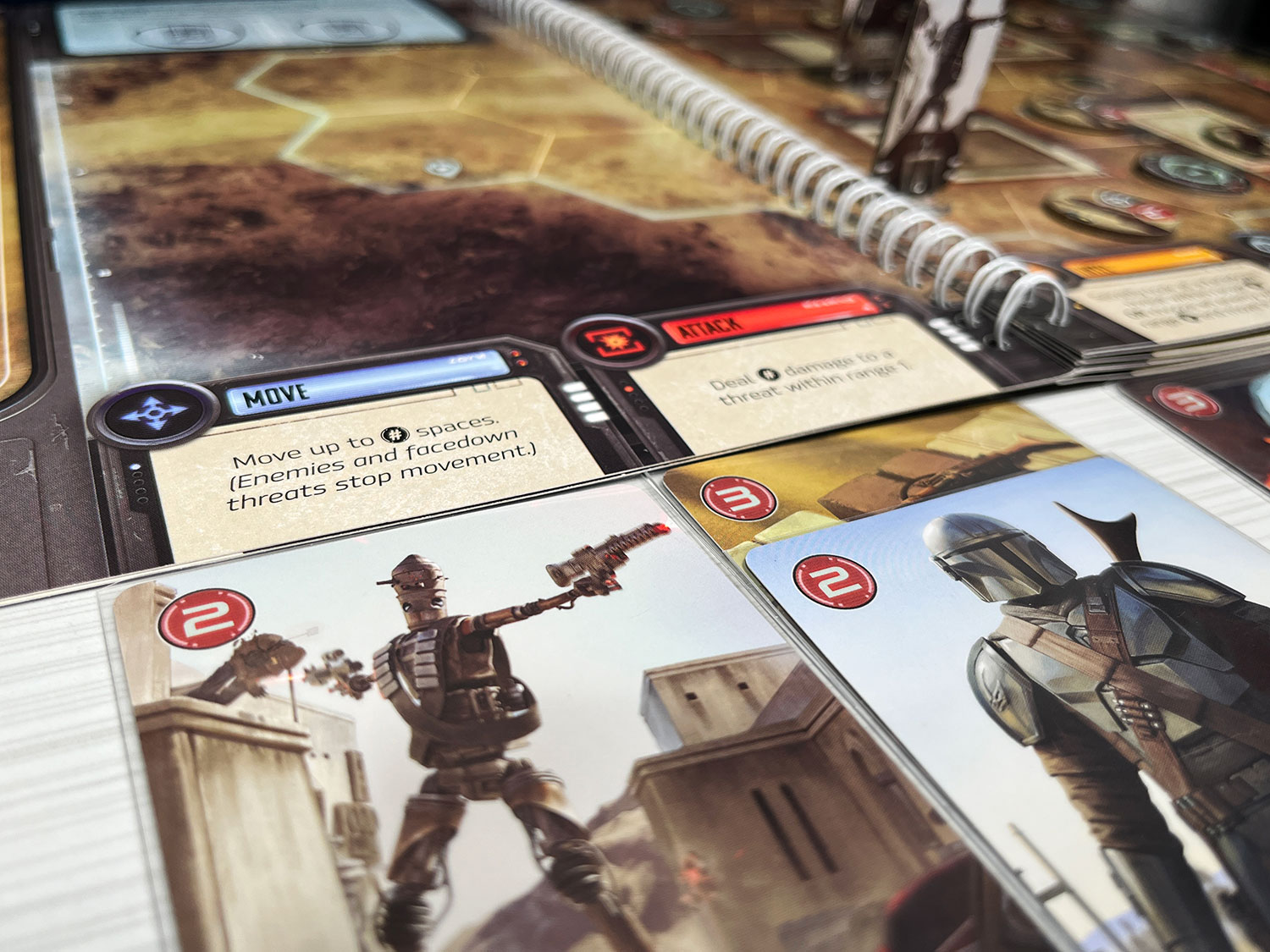
Final Thoughts:
“Weapons are part of my religion“
The Mandalorian: Adventures is a highly thematic game that closely parallels the series with the content and missions. The action slot mechanics are an excellent design that allows players to choose their fate and the skills decks add to the overall theme and level up all characters included in the game, not just the ones that were on the mission. The mission book is another component that adds thematic elements like the comic that sets up each mission included and provides exceptional detail for the players so rules reference and player aids are not required. Now what holds The Mandalorian: Adventures back from scoring higher is the short campaign and possible mission content that were missing from Season 1.
Final Score: 4.0 Stars – A great and highly thematic cooperative game that includes excellent player decision-making mechanics set within the Mandalorian Season 1.
 Hits:
Hits:
• Highly Thematic
• Action Slots
• Skill Decks
• Mission Book
Misses:
• Campaign feels short
Disclosure: Someone who helped work on the art for The Mandalorian: Adventures also writes for Board Game Quest. He had no influence over the opinions expressed in this review.
Source: Board Game Quest



